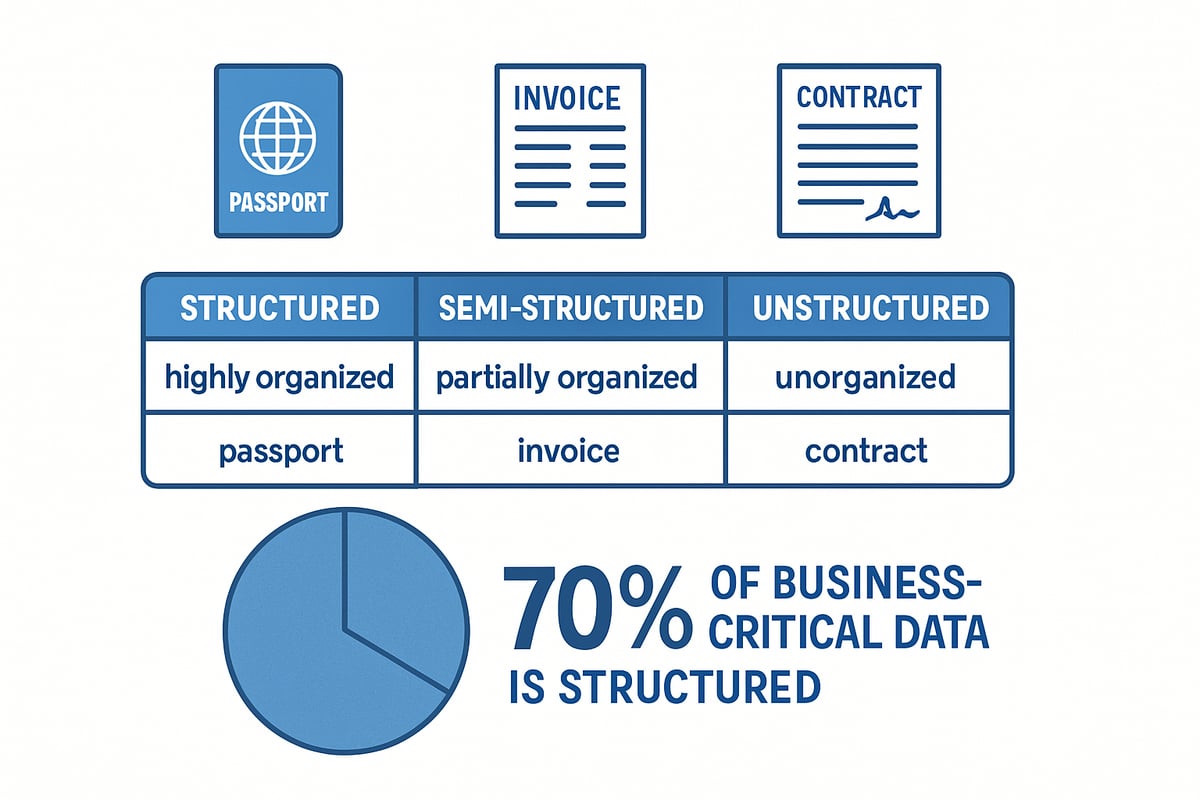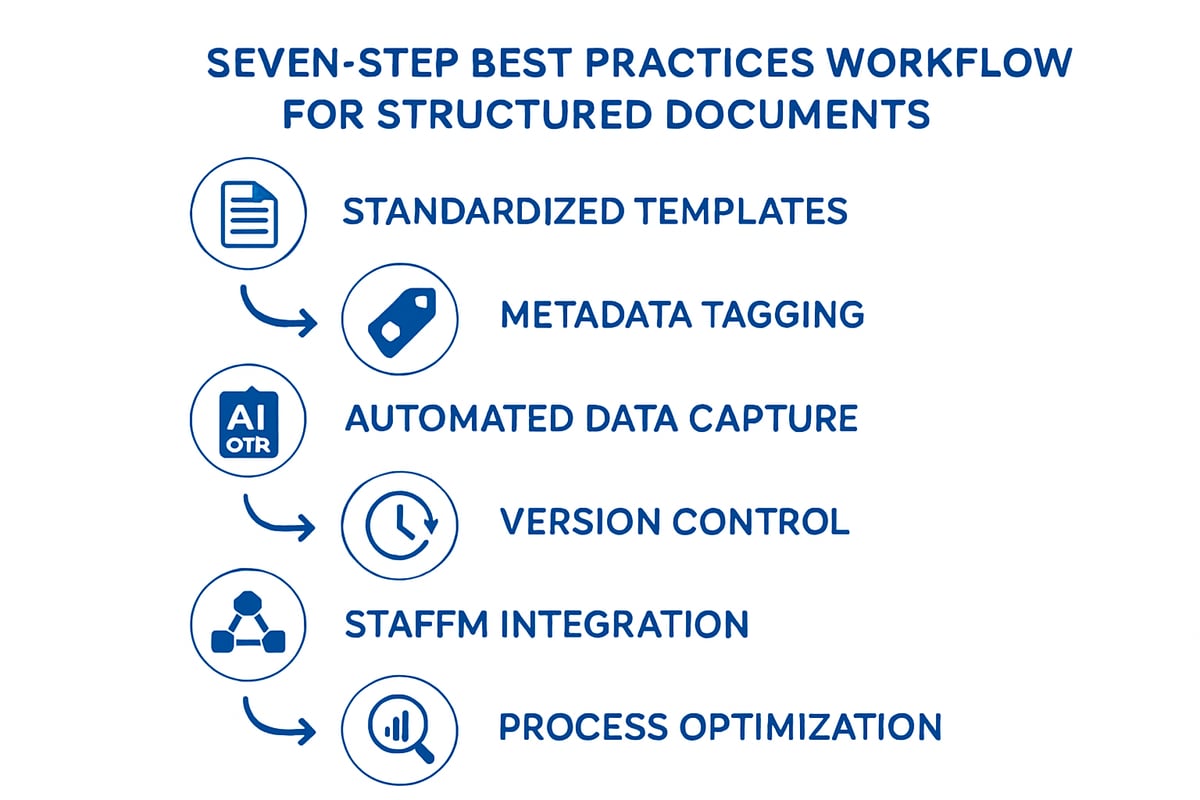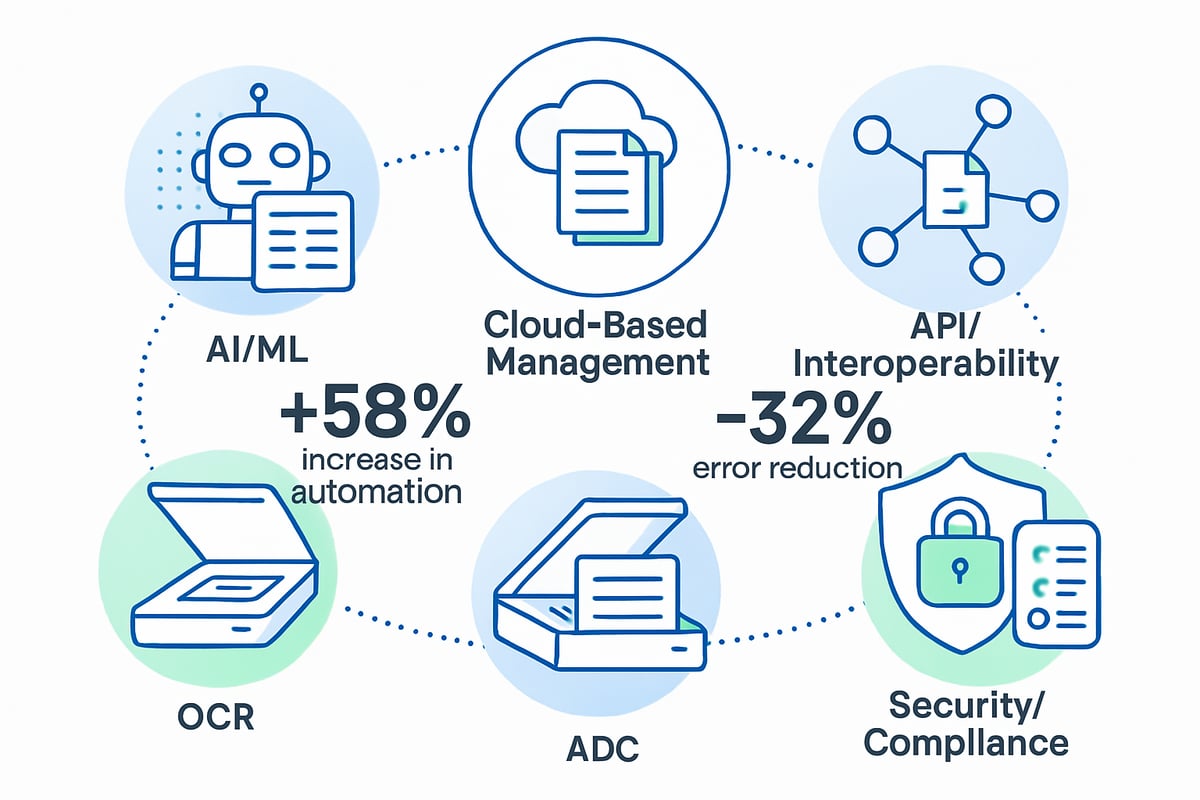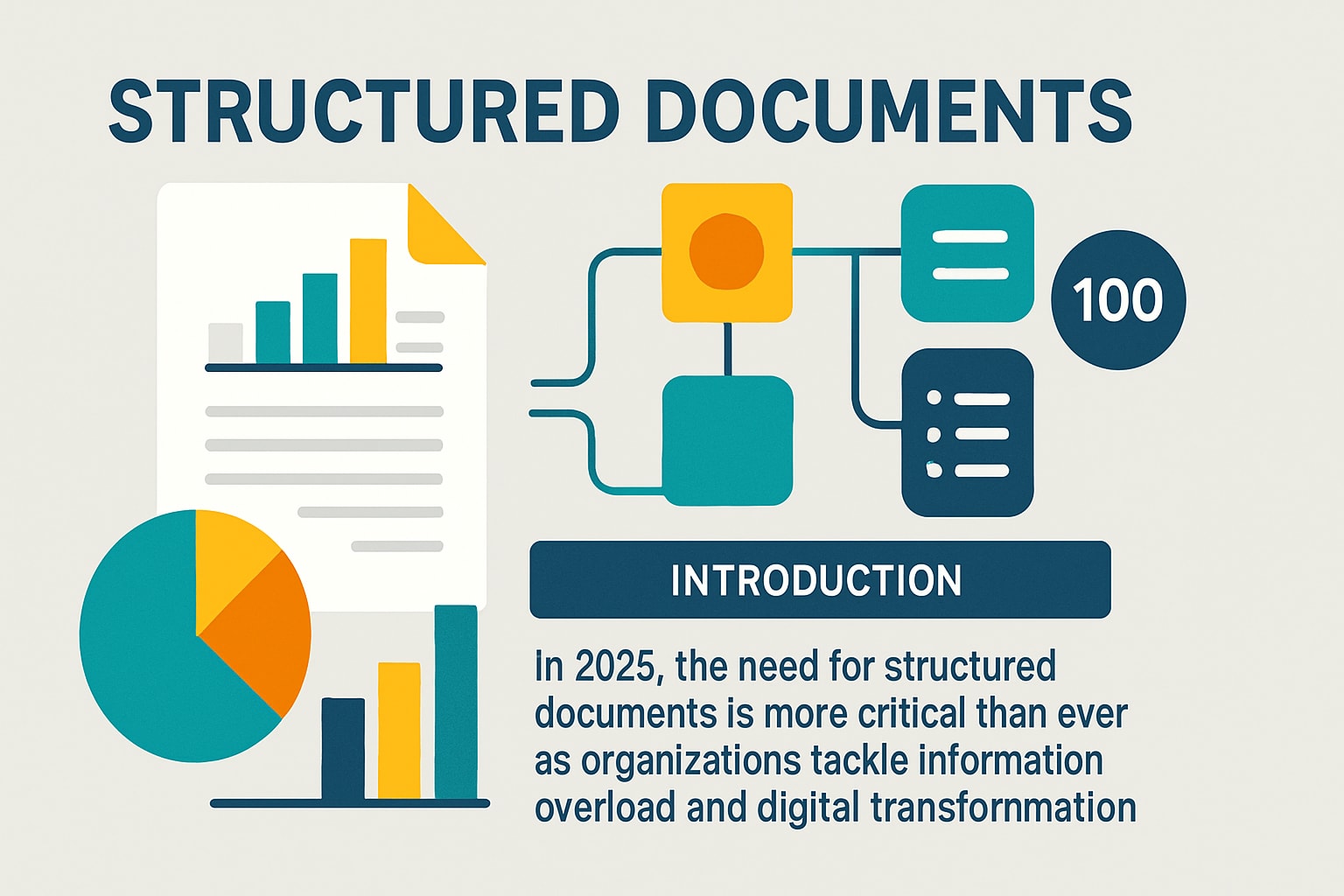In 2025, organizations face an unprecedented surge in digital information, making it essential to bring order and clarity to business processes. As digital transformation accelerates, many are overwhelmed by fragmented data and chaotic document management.
This guide is your roadmap to mastering structured documents. We will define what they are, compare them with other document types, explore their unique benefits, break down best practices, and look ahead to future technology trends and challenges.
Ready to move beyond document chaos? Discover how implementing structured documents can streamline operations, improve compliance, and position your organization for success.
Understanding Structured Documents: Definitions and Types
In today's data-driven world, organizations rely heavily on structured documents to manage, process, and extract business-critical information. These documents use a predefined schema, fields, and consistent layout, making them essential for digital transformation and efficient operations.
Structured documents differ from other document types by their level of organization. To better understand this, let’s compare structured, semi-structured, and unstructured documents side by side:
| Document Type | Definition | Example | Structure Level |
|---|---|---|---|
| Structured | Data organized in fixed fields and schema | Passport | High |
| Semi-Structured | Some organization, flexible fields | Invoice | Medium |
| Unstructured | Free-form, no predefined schema | Legal contract | Low |
Structured documents, such as passports, store information in clearly defined fields. Semi-structured documents like invoices blend fixed and variable elements. Unstructured documents, such as legal contracts, lack a consistent format, making them harder to parse and analyze.
Common formats for structured documents include PDFs with form fields, digital forms, XML, JSON, and relational databases. Each format offers different advantages for capturing, storing, and retrieving data. For instance, XML and JSON are widely used for data exchange in web applications, while databases provide robust querying and reporting capabilities.
Industries that rely on structured documents include government, finance, healthcare, and education. These sectors handle sensitive information and require accuracy and compliance. For example, governments use structured documents for identity cards and licenses. The finance sector processes tax forms and loan applications, while healthcare organizations manage patient records with predefined fields.
Here are a few real-world examples of structured documents:
- Loan applications with standardized fields for applicant data
- Tax forms with uniform sections for income and deductions
- Standardized business reports with consistent layouts
According to Document Processing Statistics for 2025, approximately 70% of business-critical data is stored in structured formats. This widespread adoption highlights the importance of structured documents in modern organizations.
Why does structure matter? Structured documents enable automation, streamline compliance, and improve data accuracy. Automated validation ensures that required fields are filled correctly. Consistent layouts reduce errors and support reliable analytics. For regulated industries, structured formats simplify auditing and reporting.
However, many organizations face challenges with legacy document formats during digital transformation. Older systems may use unstructured or semi-structured files, making migration and integration complex. Extracting data from unstructured sources often requires advanced tools and manual intervention, which increases time and costs.
Comparing data extraction, structured documents are far easier to process than unstructured ones. Automated tools can quickly extract key fields from structured documents, while unstructured data often demands human review and specialized software.
As organizations modernize, the move toward structured documents is essential for unlocking automation, ensuring compliance, and supporting business growth.

Key Benefits of Structured Documents in 2025
Modern organizations are recognizing the immense value structured documents bring to business operations in 2025. With information volumes surging, the need for reliable, automated, and compliant document management has never been greater.
Structured documents offer distinct advantages across accuracy, efficiency, compliance, scalability, and financial return. Let’s explore these benefits in detail.
![]()
Enhanced Data Accuracy and Consistency
Structured documents provide a foundation for precise and reliable business processes. Automated validation checks minimize errors during data entry, ensuring all required fields are complete and accurate before submission.
Uniform field structures enable organizations to generate consistent reports and analytics, supporting better decision making. For instance, tax forms with standardized fields reduce compliance risks by eliminating ambiguity in reporting.
Recent advancements, such as TWIX: Reconstructing Structured Data from Documents, demonstrate how innovative tools can extract and validate data from templated documents, further improving the accuracy and efficiency of structured documents. When organizations rely on structured documents, they minimize costly mistakes, reduce manual corrections, and build trust in their data.
Improved Efficiency and Automation
In 2025, structured documents are essential for automating repetitive tasks and accelerating business workflows. By leveraging integration with robotic process automation (RPA), AI, and workflow management tools, organizations can process large volumes of information quickly and accurately.
Structured documents enable seamless data exchange between systems, reducing manual data entry and retrieval efforts. For example, automated loan processing in banking relies on structured application forms to verify information and approve applications faster.
Teams benefit from streamlined processes, as structured documents support real-time validation and routing. This not only improves productivity but also allows staff to focus on higher-value tasks, maximizing organizational efficiency.
Regulatory Compliance and Security
Managing compliance and data security is a top priority for any organization. Structured documents simplify the implementation of access controls and audit trails, making it easier to track document usage and modifications.
Compliance with regulations like GDPR, SOC 2, and industry-specific standards becomes more manageable when information is organized in a structured format. Healthcare providers, for instance, use structured documents to handle patient data securely and ensure privacy requirements are met.
By using structured documents, organizations can quickly respond to audits, enforce data retention policies, and reduce the risk of data breaches.
Scalability and Interoperability
As organizations grow, they need document solutions that can scale and adapt. Structured documents support interoperability through standardized formats such as XML, JSON, and EDI, making it easier to exchange data across platforms.
This interoperability is vital for digital transformation initiatives, where information must flow seamlessly between departments and external partners. Government agencies, for example, use structured identity documents that are recognized by multiple systems and agencies.
Structured documents also enable organizations to adapt to changing requirements without overhauling their entire document infrastructure, supporting long-term scalability.
Cost Savings and ROI
One of the most compelling benefits of structured documents is the reduction in operational costs. By eliminating manual processing and minimizing errors, organizations save time and resources.
Automated document management leads to faster turnaround times and less need for rework. Many organizations report up to an 80% reduction in document processing time after adopting structured formats, resulting in a significant return on investment.
With structured documents, businesses can reinvest savings into innovation, staff development, and other strategic priorities, driving sustainable growth.
Best Practices for Creating and Managing Structured Documents
Creating and managing structured documents effectively is vital for organizations seeking accuracy, compliance, and efficiency. Let's explore proven best practices that streamline document processes and foster a culture of reliability and innovation.

Standardize Document Templates and Schemas
Begin by establishing consistent templates for all common document types within your organization. Standardization ensures every instance of structured documents adheres to the same schema, field order, and format. This consistency not only accelerates onboarding but also enhances data accuracy.
Adopt industry standards where possible. For example, healthcare organizations can use HL7, and financial teams may rely on XBRL. Create a centralized repository of approved templates for invoices, contracts, and reports.
Standardized templates make it easier to update requirements and maintain compliance. They also reduce confusion among staff, ensuring everyone works from the same foundation.
Leverage Metadata and Tagging
Enhance structured documents by embedding metadata and using robust tagging systems. Metadata makes documents searchable, sortable, and easier to classify. Automated tagging tools can assign consistent categories, owner information, and expiration dates.
For example, tagging contracts with renewal dates allows alerts for timely action. Metadata fields such as author, department, and document type help teams locate files quickly.
Implementing a metadata strategy supports compliance and information governance. It also lays the groundwork for advanced analytics and process automation.
Automate Data Capture and Validation
Leverage automation tools to extract and validate data from structured documents. Modern OCR and AI technologies can convert scanned forms or images into usable digital data, reducing manual entry errors.
Set up validation rules to detect missing or inconsistent fields immediately. This approach ensures that only high-quality data enters your business systems.
For example, automated extraction of loan application details can speed up processing while maintaining accuracy. Automation not only saves time but also reinforces data integrity across all structured documents.
Ensure Version Control and Auditability
Managing revisions is crucial for structured documents, especially in regulated industries. Utilize document management systems with built-in version control features. These platforms track changes, record user actions, and maintain comprehensive audit logs.
For instance, policy documents often undergo multiple updates to meet compliance standards. Version history allows organizations to trace changes, restore previous versions, and demonstrate accountability during audits.
Auditability also helps in identifying unauthorized changes or errors, providing a clear chain of custody for every document.
Integrate with Business Systems and Workflows
Maximize the value of structured documents by connecting them with core business platforms like ERP, CRM, and analytics tools. Integration enables real-time data synchronization, automatic updates, and seamless reporting.
For example, when structured intake forms feed directly into a CRM, customer information is instantly available for sales and support teams. Platforms such as the Introducing OdysseyGPT platform illustrate how advanced solutions can simplify integration and management of structured documents across diverse workflows.
Effective integration reduces redundant data entry and supports agile business operations.
Train Staff and Maintain Documentation Governance
Empower employees with clear guidelines and regular training on structured documents. A well-informed team is essential for consistent data handling and compliance.
Develop a governance policy that outlines document creation, modification, storage, and retention procedures. Schedule periodic training sessions and provide resources to address questions or changes in standards.
For example, onboarding programs for new hires should include modules on document management protocols. Ongoing governance ensures adherence to best practices and reduces risks associated with improper document handling.
Monitor, Review, and Optimize Processes
Continuous improvement is key to sustaining efficient structured documents practices. Regularly monitor document-related workflows using analytics and audit tools. Review processes to identify bottlenecks, redundancies, or compliance gaps.
Conduct quarterly audits to assess adherence to standards and uncover opportunities for optimization. Use feedback from users to fine-tune templates, automation rules, and governance policies.
Optimization not only boosts performance but also ensures that your approach to structured documents evolves with business needs and regulatory changes.
Technology Trends Shaping Structured Documents in 2025
The landscape for structured documents is changing rapidly as new technologies redefine how businesses capture, process, and protect information. Organizations that want to stay competitive in 2025 must understand the key innovations shaping document management. These emerging trends promise to boost efficiency, accuracy, and compliance for every industry relying on structured documents.

AI and Machine Learning for Document Processing
AI and machine learning are revolutionizing how structured documents are processed. Modern systems use natural language processing (NLP) and machine learning to extract, classify, and validate data from complex forms and reports. This technology significantly reduces manual effort and increases data quality.
For instance, large language models can analyze financial documents, detect anomalies, and improve compliance. If you want to explore how AI models handle multi-structured documents, the research on Comprehensibility of Multi-structured Financial Documents offers valuable insights. As organizations handle more structured documents, leveraging AI will be crucial for keeping up with growing data volumes and complexity.
Advanced OCR and Intelligent Document Recognition
Optical character recognition (OCR) technology has made significant strides. The latest OCR engines can now process structured documents with complex layouts, tables, and even handwritten text. Intelligent document recognition combines OCR with AI to interpret field context, automate data capture, and identify errors.
This evolution means legacy documents and semi-structured records can be digitized and integrated into modern workflows. As structured documents become more prevalent, advanced OCR tools enable faster transitions from paper to digital, unlocking automation and analytics potential.
Cloud-Based Document Management Solutions
Cloud-based platforms are becoming the backbone for managing structured documents. These solutions centralize storage, streamline sharing, and facilitate remote collaboration. With the cloud, organizations can scale document management operations without worrying about physical infrastructure.
Cloud systems also support integration with analytics and workflow automation tools, enabling real-time access to structured documents from anywhere. This flexibility is vital for businesses with distributed teams or evolving compliance requirements.
API-First and Interoperability Standards
The API-first approach is transforming how structured documents are exchanged between systems. Open standards like JSON, XML, HL7, and XBRL ensure that data remains consistent and machine-readable across platforms. APIs simplify integration with ERP, CRM, and analytics tools, supporting seamless workflows.
By adopting interoperability standards, organizations future-proof their structured documents and enable efficient data sharing with partners, customers, and regulators. This trend is driving digital transformation initiatives across sectors.
Security, Privacy, and Compliance Innovations
Security and privacy are top priorities for structured documents in 2025. Modern document management solutions offer end-to-end encryption, granular access controls, and automated compliance checks. These features help organizations comply with regulations like GDPR and SOC 2 while protecting sensitive information.
Automated redaction tools can identify and mask confidential data before sharing documents externally. As regulatory landscapes evolve, continuous innovation in security technology ensures that structured documents remain trustworthy and compliant.
Step-by-Step Guide: Implementing Structured Document Best Practices
Implementing structured documents in your organization requires a clear, methodical approach. This step-by-step guide outlines how to transition from scattered, inconsistent files to a streamlined, compliant, and efficient document ecosystem.
Step 1: Assess Current Document Landscape
Start by taking stock of all existing structured documents and related formats in your organization. Compile an inventory of document types, storage systems, and data sources. Identify which documents are structured, semi-structured, or unstructured.
Look for bottlenecks, outdated templates, and manual processes. For instance, an audit may reveal that 40 percent of existing forms lack standardization, leading to inefficiencies. Use a simple table to categorize document types and note areas needing improvement:
| Document Type | Format | Issues Identified |
|---|---|---|
| Loan Application | PDF/XML | Inconsistent fields |
| Tax Form | Outdated template | |
| Contract | Word | Unstructured data |
This foundational step ensures you understand your current landscape before making changes to your structured documents.
Step 2: Define Structure and Standards
Establish clear templates and data schemas for your structured documents. Collaborate with stakeholders to identify business and regulatory requirements that impact document design. Refer to industry standards such as HL7 for healthcare or XBRL for finance to promote interoperability.
Create standardized templates for critical workflows like HR onboarding or invoicing. Document each template’s fields and validation rules. By enforcing structure, you improve data quality and compliance.
To further strengthen your approach, consult resources like the buyer trust signals checklist to ensure your standards align with compliance and security best practices for structured documents.
Step 3: Select Tools and Technologies
Choose document management systems, OCR solutions, and automation tools that are compatible with structured documents. Evaluate platforms for integration with your existing ERP, CRM, and analytics systems.
Prioritize solutions that support automated data extraction, metadata tagging, and version control. Look for cloud-based platforms for scalability and secure remote access. For example, select a tool that can extract structured data from scanned forms and synchronize it with your business applications.
Make sure your chosen technologies align with your document lifecycle needs and support future growth as you scale your structured documents strategy.
Step 4: Migrate and Digitize Legacy Documents
Transitioning legacy and paper-based files into structured documents is essential for digital transformation. Use batch OCR and AI-powered tools to convert scanned images and unstructured files into standardized digital formats.
Establish validation processes to ensure accuracy during migration. For example, digitize archived contracts, then review extracted fields for completeness and correctness. This step often uncovers hidden issues and helps eliminate outdated, redundant files.
Organize migrated documents into your new templates to maintain consistency. This process lays the groundwork for improved automation and compliance using structured documents.
Step 5: Train Teams and Monitor Adoption
Educate staff on new structured documents standards, templates, and workflows. Offer hands-on training, user guides, and ongoing support. Encourage feedback to identify pain points and areas for further optimization.
Track adoption rates and monitor usage patterns. Use analytics and regular reviews to ensure compliance and continuous improvement. Refer your team to the OdysseyGPT blog homepage for up-to-date resources on document management and digital transformation.
Effective training and governance ensure that structured documents deliver long-term value, efficiency, and reliability for your organization.
Overcoming Common Challenges and Future Outlook
In 2025, organizations are navigating a fast-evolving landscape where structured documents are essential for operational excellence. Yet, even with advanced tools, common challenges persist. To stay competitive, businesses must understand these hurdles and proactively prepare for the future of structured documents.
Addressing Legacy and Semi-Structured Document Issues
Legacy systems and semi-structured files remain a significant barrier to fully leveraging structured documents. Many industries, such as finance and real estate, still rely on mixed-format records that complicate automation and data extraction.
To overcome these obstacles, organizations can:
- Use AI-powered tools for intelligent data extraction
- Apply human-in-the-loop workflows for complex cases
- Prioritize high-impact document types for conversion
The mortgage industry, for example, has gradually transitioned from paper-heavy, semi-structured files to digital, structured documents. Emerging frameworks like FlexDoc: Generating Synthetic Documents for Training help train AI models to better understand diverse document layouts, accelerating the shift. Addressing these issues is vital for unlocking the full potential of structured documents.
Balancing Flexibility with Standardization
While standardization is key for structured documents, some level of flexibility is necessary to meet diverse business needs. Rigid templates can stifle innovation and fail to accommodate unique cases, yet too much customization can erode the benefits of structure.
Best practices include:
- Creating modular templates with customizable sections
- Using field-level options for exceptions
- Setting core standards while allowing limited variations
For example, a global enterprise may standardize its invoice format but permit regional teams to add fields specific to local tax laws. This balance ensures structured documents remain efficient, relevant, and adaptable as business requirements evolve.
Ensuring Scalability and Performance
The growth of digital content means structured documents must scale seamlessly. As organizations expect document volumes to double by 2027, performance, accessibility, and speed become critical. Cloud-based solutions and automated indexing are essential for handling large, complex document repositories.
Key strategies:
- Leverage elastic cloud infrastructure for storage and processing
- Automate indexing and metadata tagging for faster retrieval
- Monitor system performance and user access
Optimizing for web performance also ensures that structured documents are accessible and responsive, especially for B2B platforms. For more insights, see Core Web Vitals for B2B sites. By investing in scalable infrastructure, organizations can future-proof their structured documents and maintain efficiency at scale.
Managing Security, Privacy, and Compliance Risks
Protecting sensitive data within structured documents is a top priority. The regulatory landscape is constantly changing, making compliance a moving target. Organizations must implement robust controls to safeguard information and ensure auditability.
Consider these actions:
- Enforce granular access controls and user permissions
- Maintain comprehensive audit trails for document activity
- Automate compliance checks for evolving regulations
Automated alerts for GDPR-sensitive data, for instance, help organizations respond quickly to privacy risks. As structured documents become more interconnected, a proactive approach to security and compliance helps prevent costly breaches and penalties.
Preparing for Emerging Technologies and Trends
The future of structured documents will be shaped by rapid advances in technology. AI-driven document reasoning, blockchain for authenticity, and quantum-safe encryption are on the horizon. Staying agile is critical for adopting innovations that enhance document integrity and automation.
Forward-thinking organizations should:
- Monitor emerging tech and pilot new solutions
- Invest in upskilling teams for AI and automation
- Adopt flexible platforms that support future integrations
For example, early adoption of AI-based document reasoning tools can provide a competitive edge. Initiatives like FlexDoc also signal a shift toward more intelligent, adaptable document processing. Remaining alert to these trends ensures structured documents continue to drive value in a changing digital world.
As we’ve explored, mastering structured documents unlocks accuracy, efficiency, and real clarity in your workflows—especially as we look ahead to 2025’s fast-evolving demands. If you’re ready to move beyond static files and want to interact with your documents in a smarter, more conversational way, you don’t have to wait. With OdysseyGPT, you can experience advanced tools for extracting, organizing, and analyzing data across any document format, all in one platform. Let’s turn your document chaos into an intelligent, searchable knowledge base—give it a try and Start free trial.

